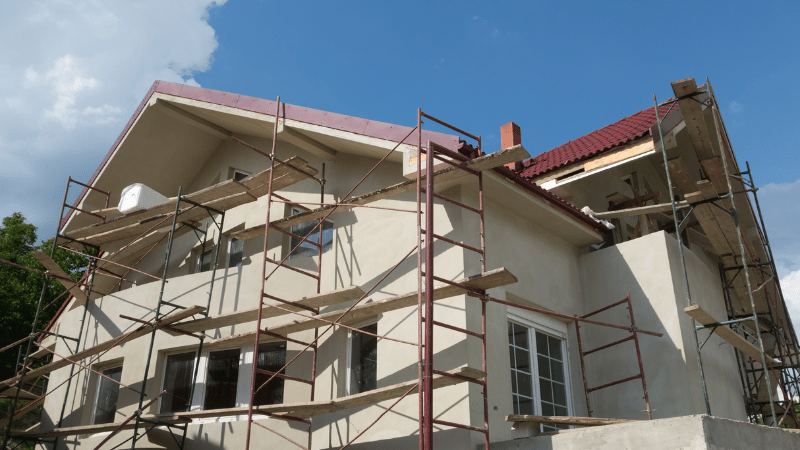Categories
Remortgage for Home Improvements [+4 Alternatives]

When it comes to home improvement loans, a remortgage is often the top consideration - but is it your best option?
At Clifton Private Finance, we work with a wide range of finance options to ensure that you get the capital you need with the best rates and most flexible terms.
If you are looking to add an extension to your house, turn your loft into an additional bedroom, or make changes to your room layout for accessibility reasons later in life, then a remortgage for home improvements may be the perfect choice - but it always pays to consider the alternatives.
Find the Perfect Remortgage Deal
The 8 Considerations when Considering Home Improvement Finance
Funding your home improvement project is not as simple as choosing the one with the best rate.
There are a range of finance products available in the UK, from both high-street banks and more specialised lenders. Our specialists are here to help you navigate the complexities of the lending landscape and will make sure you get the home improvement loan that’s right for you.
Major considerations include:
Size of Funding Required
There’s a big difference between wanting £50,000 to convert a section of your home into multiple bedrooms with en-suite bathrooms, and a £3,000 project to improve accessibility. Identifying your required budget is essential when evaluating the options.
Repayment Terms
Remortgages are powerful because they can give you access to large sums of money at a low rate, with the lender’s risk mitigated by your home as a strong security.
Interest Rates
The amount you pay for your loan is a very important consideration. Remortgages hold their ground well here, too, with extremely low interest rates when compared to many other options.
Shorter-term loans and unsecured finance may seem convenient, but the higher rates can make it more expensive than you may want.
Flexibility
Being able to do more with your loan may be important. Flexibility doesn’t just mean in terms of payment structure, it can also be considered with regards to how you use the money, whether refinancing is available later on, and the conditions which lock you into the finance. Remortgages can vary in their flexibility, so it’s important to understand the exact nature of your loan before signing the agreement.
Impact and Consequence
A loan represents an agreement between you and the lender, and it’s essential that you understand precisely that agreement and how it could affect you both now and in the future.
Remortgages are secured on your property and if the worst comes to the worst, you may find yourself losing your home if you don’t meet repayments. Some loans have significant early repayment charges, while others will put a greater strain on your monthly finances, limiting your future options.
Added Value
While it’s not a direct consideration when making your loan choice, calculating the expected increase in value on your property through making the improvements and then balancing that against the cost of your loan will help you understand that you’re making the right decision.
A good home improvement project will bring more to your long-term portfolio than its overall cost, making home improvement remortgages a strong investment as well as a way to modernise your home.
Limitations
Not every loan is available for every customer. When you’re considering a long-term financial agreement, such as a remortgage, your age and your income will play a large part in defining the options available for you. A full understanding of loan limitations should form part of your planning.
End Plan
Finally, it’s worth knowing your why when it comes to taking out a home improvement loan: is this project simply to make your house a little nicer to live in? is it to provide additional space for a growing family? a redesign to make the home more suitable for your old age? or an investment designed to increase property value for an immediate sale? Your end plan will help define the loan structure that’s right for your home improvement project.
4 Other Loans for Home Improvements
Getting the support and funding for your home improvement project can be done in several ways. All loans have their advantages and disadvantages and it’s important to understand how these factors affect your management of the finance.
Remortgage
As discussed, one of the strongest home improvement loan options, a remortgage involves a complete refinancing of your home mortgage.
Your mortgage is considered a first-charge loan secured against your property, which means that it has the lowest risk for your lender. This leads to superior interest rates and more flexible terms.
Pros
- Ability to access higher loan values - perfect for larger home improvements
- Lower interest rates than second-charge loans
- Refinance existing mortgage for improved terms
- Smaller monthly repayments
Cons
- Lengthier application process
- Strict credit searches and affordability checks
- Market conditions may mean rates may not be better than existing mortgage
- Long-term loan commitment
To get the most out of a remortgage, it’s necessary to consider all your options with multiple lenders. The best way to do this is to work with a specialist broker.
Clifton Private Finance provides all the experience and market reach that you need to obtain the lowest rates and most flexible terms, connecting you to remortgages tailored for home improvements.
Second-Charge (Homeowner) Loans and HELOCs
A second-charge loan, sometimes called a home-secured loan or homeowner’s loan, is a loan that’s separate to your existing mortgage but also guaranteed by using your home as collateral. Because the mortgage is first-charge, which means that it takes legal priority should you become unable to make repayments, a second-charge loan is a greater risk for the lender.
As a borrower, a second-charge mortgage provides an effective way to raise the money needed for home improvements, securing a relatively low rate through leveraging the home as collateral, while leaving the primary mortgage untouched - valuable if the existing rate and terms are extremely strong.
Second-charge loans can be varied and flexible, with some offering short-term repayment options to clear as quickly as possible, while others allow you to keep monthly impact low through longer-term structures.
Pros
- Large value loans based on home equity
- Competitive interest rates
- No impact on current mortgage
- Flexible repayment structures
- Relatively short application process
Cons
- Higher interest rates than remortgage options
- Limited use for homeowners without significant property equity
- More expensive when stretched over long terms
A Home Equity Line of Credit (HELOC) is a versatile and dynamic financing solution that enables homeowners to borrow against the equity in their property, offering far greater flexibility than a traditional second charge mortgage.
Widely used in the US and now emerging in the UK market, HELOCs provide a revolving credit facility. This allows you to draw funds as needed, rather than receiving a full lump sum upfront. You only pay interest on the amount you actually use, making it particularly suitable for high-value, phased refurbishment projects where costs may change over time.
Key Benefits of a HELOC
- Flexible Access to Funds: Draw down funds as required. Interest only applies once money is withdrawn.
- Pay Interest Only on What You Use: Avoid unnecessary costs by paying interest solely on the utilised balance.
- No Early Repayment Penalties: Repay whenever you choose, without incurring charges.
- Up to 5-Year Term: Benefit from a longer financing period than typical bridging loans.
- Keep Your Main Mortgage Intact: Ideal if your current first charge mortgage has favourable terms or is nearing renewal.
- Coordinate with Mortgage Expiry: Structure your HELOC to finish when your main mortgage is due, streamlining the remortgaging process after refurbishment.
Unsecured Personal Loans and Credit Cards
Unsecured financing - which includes personal loans, credit cards, and bank overdrafts - is available for lower-value (under £25,000) lending. Instead of being secured through your home equity, an unsecured loan is provided as an option based mainly on your credit report. While they can be quick and easy to obtain, the rates are rarely competitive when compared to a remortgage, and the ongoing cost when used for home improvements can be significantly higher.
Unsecured loans and credit cards are typically best used to plug a gap in your existing finance, perhaps used when a project goes slightly over budget or if unexpected problems occur that need a quick response. Their high rates mean that they are completely unsuitable for longer-term lending.
Pros
- Quick and easy to obtain
- No impact on current mortgage or existing homeowner loans
- Flexible use
Cons
- Far higher interest rates
- Based on credit history, making them difficult or more expensive for those with poor-to-middling credit scores
- Smaller loan sizes
- Greater risk of debt spiralling if poorly managed
Bridging Finance
Bridging loans are a specialised short-term funding option that is perfect for home renovations for distinct corner cases. These include:
- When a remortgage isn’t possible - this may be because the property is in a state of disrepair or proving income is difficult, for example.
- When an opportunity requires rapid action - remortgages can take months to put in place effectively, often requiring temporary bridging finance for the interim.
- When the sale of the refurbished property is the ultimate goal - house flipping or to improve the market value of an inherited home before sale, for example.
- When money is needed for additional secondary needs - such as to cover care costs if moving out of the home, or to pay inheritance tax.
Bridging finance provides you with additional power for your home improvement needs, getting money fast and with an ‘exit based’ repayment strategy that means no monthly payments and no fees incurred for repaying the loan early. With a bridging loan, you can get the money you need today and refinance it immediately once the longer process of securing the right remortgage deal is completed, allowing you to move forward with your home improvements without having to rush your remortgage agreement.
Pros
- Extremely fast to obtain
- High-value loans
- Exit-based repayment structure
- High flexibility
- No early repayment charges
- Acceptance based on property equity and not credit rating or affordability tests
Cons
- A well-considered exit strategy (either refinance or property sale) is essential
- Unsuitable for long-term financing
- High levels of property equity required, either in single or multiple properties
Bridging finance is especially effective for homeowners looking to buy a new property and renovate immediately. Speak to a Clifton Private Finance bridging expert today, or try our calculator below.
Get started with our calculator
Equity Release and Lifetime Mortgages for the Over 55s
If you are looking to renovate your home in retirement, then equity release products, including lifetime mortgages and retirement interest-only (RIO) mortgages, provide a worthwhile option. These mortgage structures have no monthly repayment to impact your day-to-day finances, but are repaid in full when you no longer live in the property, typically through the sale of the house.
Lifetime mortgages allow you to release the money you have saved into your house through the years of ownership, allowing you to make the renovations and improvements you need without putting a strain on your pension.
Limited to homeowners over 55, equity release products are extremely powerful and can be used to do more than just spruce up your home, with money that can be released to help other family members, purchase a retirement property, pay off other outstanding debts (including the balance of any existing mortgage), or to have the holiday of a lifetime. Read more about equity release in our knowledge base articles, or contact a Clifton Private Finance specialist today.
Pros
- Obtain significant funds based on your home equity
- No monthly repayments required
- No threat of losing your home
- Flexible use of capital beyond home improvements
- Range of products to suit your personal circumstances
Cons
- Interest will be added throughout the lifetime of the loan
- Only available for homeowners over 55
- Equity release loans affect the size of your estate upon death
Check Your Eligibility
Remortgages vs. Other Home Improvement Loans
For most situations, remortgages remain the primary and most effective form of home improvement loan. With the lowest cost, greatest potential value, and low impact on monthly finances, a remortgage is the best way to leverage the value of your home to pay for improvements - plus, it’s worth remembering that your home value will increase once the renovations are complete, further improving the cost-effectiveness of the remortgage.
Remortgage Considerations vs. Other Loans
|
Consideration |
Remortgage |
Other loans to consider |
|
Size of loan |
Large - Because a remortgage is typically limited only by your property value, it’s possible to get the funding you need for most home improvements, including extensions and significant conversion projects. Furthermore, a remortgage can release additional capital for non-related use, such as debt consolidation, or a well-deserved holiday. |
Bridging finance, second-charge loans |
|
Repayment |
Long but smooth - A remortgage is a long-term loan but this helps keep your monthly repayments far more manageable than most alternatives. |
Some second-charge loans. Equity release and bridging finance offer alternative unique repayment structures. |
|
Interest rate |
Low - As a first-charge loan on your property, remortgages represent the lowest risk for the lender and are also in a competitive market, with interest rates as low as possible. |
None |
|
Structure flexibility |
Good - A mortgage should be thought of as an agreement you revisit every few years as interest rates change and different options become available. Remortgages have a reasonable level of flexibility, allowing you to refinance regularly to keep the lowest payments and best deal. |
Bridging finance offers an alternative flexible structure. |
|
Impact |
Mid - As a long-term contract secured on your home, a remortgage is a significant commitment; however the low rate helps ensure a low-impact monthly repayment. |
Well-managed unsecured loans and credit cards can have a lower impact. |
The Process for a Home Improvement Remortgage
Getting a remortgage for home improvements is easy with Clifton Private Finance.
- Work out your needs - It’s always good to come forward with a solid budget for your home renovations, complete with realistic estimates for the work to be done. This prevents you getting too little finance, or paying for too much.
- Gather your documentation - Understanding your current mortgage, your income and affordability, and your current credit score is crucial. Get your numbers in order.
- Speak to a Clifton Private Finance advisor - Working together, we can determine the best form of finance for you based on your budget and circumstances, whether that’s a remortgage for the low rate and spread costs, bridging finance to take advantage of opportunity, or any other option.
- Assess the lending options - The remortgage financial landscape can feel vast and complex, but with Clifton on your side, it is easily navigated. We will match you to a lender and a remortgage product that best suits your individual situation.
- Make the application - With everything already in order and a clear plan in place, the application will go through smoothly.
- Approve the work - Once you know the money is on its way, you can instruct your renovations team to schedule the work.
- Receive the funds - The funds arrive in your bank account.
- Manage the project - Keeping a close eye on budgets and funding throughout the renovation project is important. If you need any short-term financing or other support when unexpected situations arise, Clifton Private Finance are here to help.
- Enjoy your freshly improved home - With the work done, you can enjoy the home improvements in comfort.
- Repay the financing - Settle into a comfortable repayment structure that meets your prearranged needs. Keeping an eye on interest rates and other factors means you’ll know when to come to Clifton Private Finance to refinance in the future, potentially lowering interest and improving your terms as you go.
Remortgaging for Home Improvements FAQ
Q: How much will a remortgage cost?
A: Remortgaging for home improvements does come with fees and legal costs, which you do need to consider. Additional costs may include:
- Conveyancing and surveys
- Mortgage arrangement fees
- Architectural plans
- Early repayment charges on your existing mortgage
- Broker fees
Working with Clifton Private Finance will help you minimise the additional costs. We will work together to bring the fees down, including assessing your current mortgage to time a remortgage to avoid ERCs (early repayment charges). By selecting the right lender, the additional costs of your remortgage can be kept to a minimum.
In most cases, the additional fees can be folded into your mortgage total, avoiding the need for you to find additional funds at the time of application.
Q: How long does a remortgage application take?
A: Remortgages are not the fastest loan applications, as there is a considerable amount of underwriting from the lenders that includes comprehensive affordability and stress testing, as well as a property valuation. At Clifton Private Finance we can help by combining your remortgage with bridging finance to get your project moving immediately while the longer remortgage application is undertaken.
Q: Can I get more out of my home improvement remortgage?
A: Yes. You are not limited to using the capital you raise against your home for home improvements alone. It can also be used for debt consolidation, to help out a family member, for some new furnishings, or just for a nice holiday while your house is being worked on. Discuss any additional plans with your Clifton advisor so we can fold your needs together into the remortgage total.
Q: Should I consider bridging finance and a remortgage?
A: If you are needing the money quickly, then bridging finance may provide the answer. This might be because you are purchasing a property at auction that’s in need of renovation as part of the project, or because you have a timescale to meet regarding when you need the work completed. At Clifton Private Finance, our mortgage and bridging teams work together to build a comprehensive solution for your funding needs.
Q: Why does remortgaging offer the best rates?
A: The collateral provided by your home makes a mortgage a low risk prospect for your lender, allowing them to offer the very best rates possible. Compared to other loans, such as homeowner loans, unsecured loans, and credit cards, a remortgage is extremely competitive.
Q: Do I need to stick to my current mortgage lender?
A: No. When you remortgage, you step outside your current lender, replacing your existing mortgage with the new one by repaying the current balance as part of the process. In some cases, this can lead to early repayment charges (ERCs), but well-timed remortgages will avoid these additional fees.
Getting the Best Remortgage with Clifton Private Finance
When it comes to a home renovations project, a remortgage is often the right answer, but it’s important to consider the alternatives. Speaking to a Clifton Private Finance specialist will give you the information you need to make the best decision, as well as opening your offers up to include specialise home improvement remortgages from the very best specialist UK lenders.
Contact us today to make your home improvement plans into reality, and enjoy the home you really want.

















